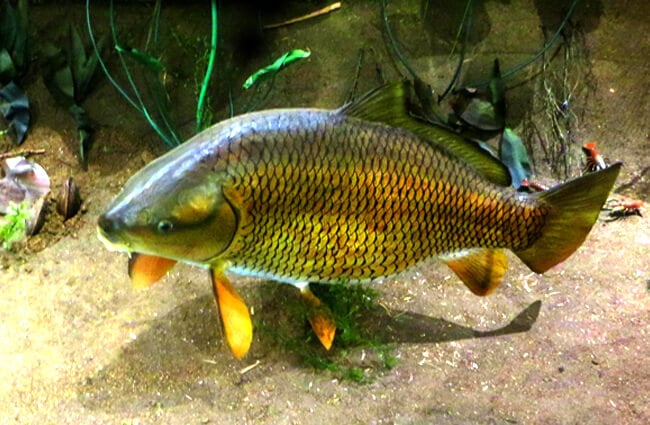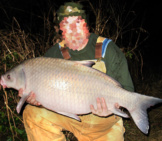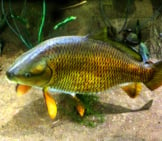The Buffalo Fish, also known as just “buffalo,” is a group in the taxonomic genus Ictiobus. Researchers recognize five different species, the Smallmouth, Bigmouth, Fleshylip, Usumacinta, and Black Buffalo. Some people catch them as sportfish, using a specialized bow and arrow. Read on to learn about the Buffalo Fish.
Description of the Buffalo Fish
These fish have broad bodies, blunt heads, and silvery gray or brown scales. Most species have mouths set on the lower portions of their faces so that they can feed along the bottom.
The largest individuals can reach 35 in. or more, depending on the species. With broad, muscular bodies, their maximum weight is about 80 lbs. or so.
Interesting Facts About the Buffalo Fish
The various species have a number of traits and adaptations to help them survive. Learn more about these, and other interesting facts about these fish, below.
- Old Fish – Researchers using carbon dating have estimated that this species can reach up to 112 years of age! That makes the fish one of the longest-lived fish species in the world.
- Easy Pickings – Fishermen do not often catch this fish using a hook and line. However, in more recent years people have been using specialized bows and arrows to hunt this fish at night. Because they swim in shallow waters, people are quite successful with this method.
- Potential Problems – In some regions, researchers have found that the vast majority of the population consists of fish over 80 years old. This means that they are not breeding successfully. Because of this, overfishing could pose a problem when the populations are not replenishing themselves.
- Detritus Diet – While feeding, these fish eat just about anything that flushes into their mouths. In fact, researchers estimate that nearly half of the things that they swallow are not even edible! The fish swallow mouthfuls of sand while filtering through it for edible bits. This sand simply passes through the digestive system and out the other end!
Habitat of the Buffalo Fish
Each species has its own unique habitat preferences. Those preferences vary based on the region the fish lives in. However, all occupy freshwater habitats and generally do not range into saltwater.
Some live in waters with slow-moving currents, while others occupy faster waters. They occupy lakes, reservoirs, ponds, rivers, streams, and more.
Distribution of the Buffalo Fish
Each of the five species has its own unique distribution and range. Some live across larger areas, while others utilize a smaller region. You can find most species in the United States, but they also range north into Canada and south into Mexico and Guatemala.
Diet of the Buffalo Fish
Diet composition changes based on which fish species you are discussing. Overall, these fish have omnivorous diets, which means that they eat both plants and animals.
However, as generalists, they eat just about anything that they can swallow. Common food items include insects, insect larvae, clams, algae, plants, plankton, and more.
Buffalo Fish and Human Interaction
Humans interact with different species in different fashions. People hunt some species as sportfish. However, fishermen generally consider these fish undesirable and mostly fish for them using bow and arrow.
The impact of human activity varies based on the species at hand. The IUCN lists some as Least Concern and some as Data Deficient.
Domestication
Humans have not domesticated these fish in any way.
Does the Buffalo Fish Make a Good Pet
No, you wouldn’t want to keep this fish as a pet. They reach a relatively large size, so you would need an extremely large tank to house them. However, some people do raise them on fish farms as a food source.
Buffalo Fish Care
People do not keep these fish as pets. Some keep them on commercial fish farms. In fish farms, people raise them in large ponds and use them as food or fish meal.
Behavior of the Buffalo Fish
These fish live in schools. Some species live in deep regions of fast flowing rivers, other species prefer slower moving regions and drift in the middle of the water column. Most forage along the bottom of the water body. They flush the sand or gravel from the bottom and snatch up anything edible.
Reproduction of the Buffalo Fish
Most species travel in schools to their breeding grounds. The groups reproduce via spawning, where the females release their eggs and the males release their sperm. In this type of reproduction, fertilization occurs outside of the body.
A single female can produce thousands of eggs in a single spawning season. It takes about a day or two for the eggs to hatch. The parents do not protect the eggs or young fry.





![Red Angus Closeup of a beautiful Red Angus cowPhoto by: U.S. Department of Agriculture [pubic domain]https://creativecommons.org/licenses/by/2.0/](https://animals.net/wp-content/uploads/2020/03/Red-Angus-4-238x178.jpg)












![Red Angus Closeup of a beautiful Red Angus cowPhoto by: U.S. Department of Agriculture [pubic domain]https://creativecommons.org/licenses/by/2.0/](https://animals.net/wp-content/uploads/2020/03/Red-Angus-4-100x75.jpg)

